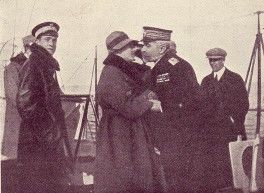
4 October 1914. One hundred years ago the first operations in the Dardanelles begun with the participation of ships of the British Royal Navy supported by French, Russian and Australian units. It was a purely naval operation at the beginning but it failed to achieve its aims due to the strong fortifications and the presence of Krupp artilleries, sea mines and German advisers. The Ottoman Empire was an unaligned power in 1914 but the British had confiscated 2 battleships constructed for the Ottoman Empire which were in British shipyards. To draw Turkey to its side Germany pretended to send a gift of two ships, the SMS Goeben and the cruiser SMS Breslau, as replacements. But in fact the crews were all Germans. The Turks decided to close the Dardanelles to Allied shipping following an incident of 27 September 1914, when the British seized an Ottoman torpedo boat. This drastic decision was actually taken by the German military advisors stationed in the Dardanelles and without informing the Ottoman government. On 28 October, the Ottoman fleet, controlled by Germans began raiding Russian ports in the Black Sea. Odessa and Sevastopol were bombarded, a minelayer and gunboat were sunk. Russia was thus forced to declare war on the Ottoman Empire on the 2 November, and the British followed suit on 6 November. On 3 November 1914, Churchill, who was First Lord of the Admiralty, ordered the first British naval attack on the Dardanelles following the opening of hostilities between Ottoman and Russian empires. This attack actually took place before a formal declaration of war had been made by Britain against the Ottoman Empire. Admiral Fisher was recalled from retirement at the end of October 1914 by Winston Churchill and forced to draw plans for a naval action in the Dardanelles, which was Churchill pet idea but the two men continually quarrelled throughout the campaign, and Fisher finally resigned on 15 May 1915 after repeated threats to do so and having abandoned his post – with calls of hang him for desertion -. Then the British carried on with their attack with the battle cruisers of Carden’s Mediterranean Squadron, HMS Indomitable and Indefatigable, as well as the obsolete French battleships Suffren and Vérité. It ended in a disaster because the battle of the 18 March 1915 resulted in a victory for the Ottoman Empire. For just 118 casualties, they sank three battleships and damaged another with mines and inflicted seven hundred casualties on the British-French fleet. That operation was originally conceived to be purely naval due to a lack of available troops but by early February, it was decided that more regular infantry was needed. Contingents of Royal Marines were to be supplemented by the last unallocated regular division, the British 29th Division. It was dispatched to Egypt, to join Australian and New Zealand troops which were already undergoing training. At the outset of the operation the expected role of the infantry was to be the occupation of Constantinople and the taking of the straits was to be accomplished by the Entente naval forces, but plans were changed. What was to become the Battle of Gallipoli, a 10-month battle of attrition, began at 07:30 on 19 February 1915. The subsequent involvement of Australian and N. Zealand troops, which were machine gunned on Gallipoli shores remains one of the blackest page in their history. Few people outside Italy remember or know that the idea of forcing the Dardanelles was though feasible by Winston Churchill because it had been somehow carried out by Italians only two years before, during the Turkish- Italian War of 1911-1912. That war ended with an Italian victory and the occupation of Libya and the islands of the Dodecanese.
The Dardanelles were forced by an Italian squadron of 5 warships (Spica, Centauro, Perseo, Astore, Climene) led by Commander Enrico Millo di Casalgiate, a native of Chiavari in Liguria (1865 – 1930) who was in command of the dreadnaught Vettor Pisani in 1911 and there he planned the violation of the Dardanelles which he actually carried out in the night between the 18 and the 19 July 1912. He himself participated, being on board of the first ship of the line up, the Spica. The idea was to use torpedoes against the Ottoman battleships anchored there but the Italian ships were spotted after breaking in and were unable to torpedo the Ottoman fleet because of intense artillery fire. Millo for his daring attempt – which proved to be a propaganda coup reported all over the world – was awarded a gold medal for bravery.
